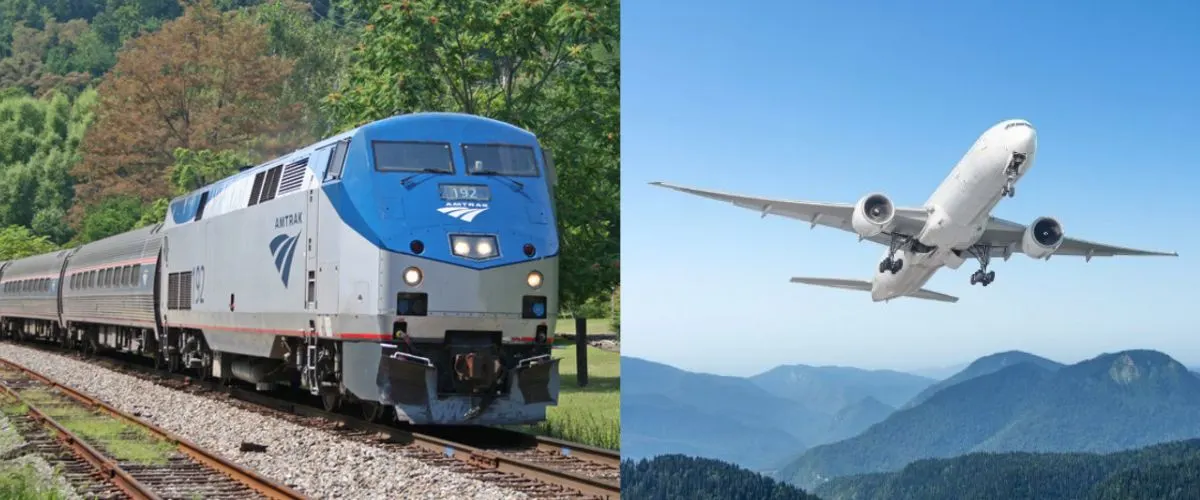
Amtrak vs Flying – What’s Right for You?
Planning a trip and not sure whether to take Amtrak or hop on a flight? It’s a common question for travelers weighing cost, time, and comfort. Both options have their advantages: trains offer spacious seating, scenic views, and less hassle at boarding, while planes are usually the fastest way to cover long distances. The choice really depends on what matters most to you: speed, budget, relaxation, or the overall experience. So, keep reading because this blog will break down the key differences so you can decide which option is the best fit for your journey.
When choosing between Amtrak and flying, it helps to compare them side by side, looking at cost, time, comfort, and more, to see which option truly fits your travel needs.
| Category | Amtrak | Flying |
|---|---|---|
| Cost | Transparent pricing with baggage included; consistent discounts for students, seniors, and frequent riders. | It can be cheaper upfront during sales, but added fees for baggage, seat selection, and extras increase costs. |
| Travel Time | Generally slower, but stations are often in city centers, saving ground transport time. | Much faster overall, but check-ins, security lines, and layovers add to total journey time. |
| Comfort | Wide seats, extra legroom, the ability to move around, and sleeper cars on long routes. | Tighter seating, limited mobility, and potential fatigue from cabin pressure. |
| Amenities | Dining cars, restrooms, Wi-Fi, power outlets, and scenic views along the route. | Varies by airline: snacks, entertainment, Wi-Fi on some; minimal extras on budget carriers. |
| Convenience | Centrally located stations, simple boarding process, and flexible change policies. | Airports are often far from cities, with longer boarding/security times, and stricter change/cancellation rules. |
| Environmental Impact | Lower carbon emissions are an eco-friendly option for sustainable travel. | Higher carbon footprint per passenger, less sustainable. |
| Travel Experience | Relaxed, scenic, and social journey with opportunities to work or rest. | Fast and efficient, but often stressful with crowded airports and long waits. |
Booking Flexibility & Changes
Compare how easy it is to change or cancel your travel plans.
| Category | Amtrak | Flying |
|---|---|---|
| Change Fees | Usually low or free with flexible fares | It can be high unless paying extra for refundable or premium tickets |
| Refunds | Full or partial, depending on ticket type | Often limited; sometimes only in the form of credits, not cash |
| Last-Minute Booking | Often easier and less costly for trains and flexible fares | Last-minute airfares are typically expensive unless deeply discounted at the last minute |
Note: Flexibility is a key factor when choosing between Amtrak and flying. Amtrak typically offers lower or no change fees and better refund options, making it easier to adjust travel plans without heavy penalties.
When to Pick Train or Plane?
Choosing between Amtrak and flying depends on your travel needs, so here are some clear situations to help you decide which option works best for your trip.
| Situation / Priority | Choose Amtrak if | Choose Flying if |
|---|---|---|
| Weather Conditions | You want to avoid major weather-related delays that often impact flights | You are traveling during seasons with fewer flight delays (e.g., summer for regional trips) |
| Work or Productivity | You want the ability to use Wi-Fi, outlets, and a stable workspace during travel. | You only need short bursts of productivity, or you can work offline while saving travel time. |
| Traveling with Kids/Family | You prefer easier boarding, roomy seating, and space for kids to move around. | You want to minimize overall travel time, even if space is limited. |
| Overnight Travel | You want a sleeper car for comfort and rest. | You prefer red-eye flights to maximize daytime at your destination. |
| Budget Flexibility | You want straightforward pricing without surprise fees. | You can be flexible to grab flash sales or low-cost flight deals. |
In the end, choosing between Amtrak and Flying depends on what matters most to a traveler. Amtrak shines on shorter routes with comfort, spacious seating, and city-center stations, making it ideal for those who value a relaxed journey and environmental friendliness. Flying generally wins for speed, especially on longer distances, but often comes with higher costs, extra fees, and airport-related stress. For trips under 500 miles, Amtrak offers a compelling alternative, while flying remains the best option for longer or time-sensitive journeys. Balancing speed, cost, comfort, and convenience helps each traveler decide the best fit.
Recent Blogs

